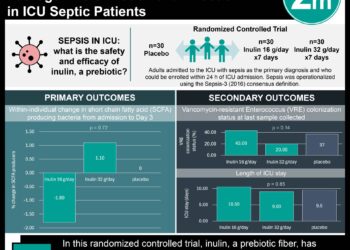New risk stratification algorithm suggested for neonatal sepsis
Image: PD
1. A new evaluation algorithm for early-onset sepsis in neonates ≥ 34 weeks gestation incorporates both maternal and newborn clinical factors to stratify into 3 groups – treat empirically, observe and evaluate, and continued observation.
2. Usage of this algorithm may decrease antibiotic treatment for 80 000 to 240 000 neonates annually in the United States.
Evidence Rating Level: 2 (Good)
Study Rundown: Sepsis is a prominent cause of morbidity and mortality in the neonatal period, requiring careful observation and judicious treatment with antibiotics. Though guidelines by the Centers for Disease Control and Prevention and the American Academy of Pediatrics suggest a clinical approach, such recommendations do not provide specifics on either severity or duration of symptoms that would necessitate a full sepsis workup or treatment. This study aims to clarify evaluation and treatment parameters by combining both maternal and newborn clinical factors into an algorithm that stratifies newborns into 3 groups – treat empirically, observe and evaluate, and continued observation – for neonatal sepsis. As data spanning almost 2 decades was used in this retrospective study, advances in maternal screening for Group B Streptococcus may contribute to variability in collected data. Despite this potential limitation, this study suggests a strong algorithm for neonatal sepsis risk stratification and may contribute to better targeting of antibiotic treatment.
Click to read the study published today in Pediatrics
Relevant Reading: The burden of invasive early-onset neonatal sepsis in the United States, 2005-2008.
Study Author, Dr. Gabriel J. Escobar, MD, talks to 2 Minute Medicine: Kaiser Permanente Division of Research and Perinatal Research Unit at Kaiser Permanente Division of Research, Oakland, California, and Department of Inpatient Pediatrics, Kaiser Permanente Medical Center, Walnut Creek, California.
“Evaluation of newborns suspected of sepsis has been highly arbitrary and characterized by huge variation across medical centers. Despite falling incidence — some hospitals, for example, have reported group B streptococcus infection rates in newborns that are zero or close to zero — the number of babies evaluated has remained constant. In this study, we have developed a new approach with the following attributes: first, we have demonstrated that it is possible to give a discrete risk of sepsis to newborns; second, this discrete risk can be used for placing babies in specific care paths; and, last but not least, it is an approach that will take maximum advantage of modern electronic medical records (the maternal algorithm can be embedded in the EMR and be available to clinicians shortly after a baby is born).”
In-Depth [nested case-control study]: This study retrospectively evaluated paper chart records of neonates born at ≥ 34 weeks gestation, and found 350 cases of sepsis at < 72 hours of age and 1063 matched controls. All cases were from 1993 – 2007 across 14 hospitals in California and Massachusetts. Maternal factors (highest antepartum temperature, gestational age, length of time of ruptured membranes, Group B Streptococcus status, intrapartum antibiotic therapy) contributed to the newborn’s sepsis risk score. This score was then combined with the neonate’s clinical picture (Apgar scoring, stability of vital signs within 12 hours of life) to stratify newborns into three categories for risk of neonatal sepsis – treat empirically, observe and evaluate, and continued observation. Using the algorithm, approximately 4% of enrolled neonates would have fallen into the “treat empirically” group, with a number needed to treat (NNT) of 118. The middle group of close observation and evaluation comprised 11% of neonates, and had a NNT of 823. Neonates with the lowest risk as determined by maternal factors and clinical presentation were stratified to the close observation group, consisting of 85% of neonates with a NNT of 9370. Of note, no laboratory data is used in this algorithm. Current rates of antibiotic treatment for neonatal sepsis at studied hospitals range from 6%-10% for all newborns; usage of this algorithm estimates a reduction of treatment to 4%. Application of the algorithm nationwide may result in 80 000 to 240 000 fewer newborns treated for neonatal sepsis.
By Neha Joshi and Leah H. Carr
More from this author: Decreased trainee autonomy suggested with in-hospital intensivist coverage, Decreased incidence of NEC with probiotic supplementation, Increased infections noted with longer duration neonatal PICC placement, Higher BMI in girls correlated with early pubertal development, Comparable outcomes suggested across antibiotic spectrum for pediatric CAP
©2012-2013 2minutemedicine.com. All rights reserved. No works may be reproduced without expressed written consent from 2minutemedicine.com. Disclaimer: We present factual information directly from peer reviewed medical journals. No post should be construed as medical advice and is not intended as such by the authors, editors, staff or by 2minutemedicine.com. PLEASE SEE A HEALTHCARE PROVIDER IN YOUR AREA IF YOU SEEK MEDICAL ADVICE OF ANY SORT.







